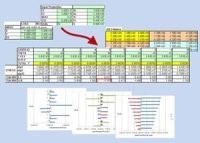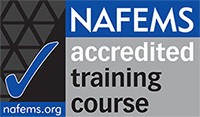Time to take a closer look at Composites FEA?
Need a clear path through analysis setup and interpretation?
This industry-leading, code-independent e-learning course gives you the background for effective FEA.
Composite Finite Element Analysis
This 5-session, live online course will cover a range of topics, all aimed at structural designers and engineers.
Composite systems include many more factors than conventional metallic structures.
The objective of this course is to break down the composite analysis process into clearly defined steps, give an overview of the physics involved and show how to successfully implement practical solutions using Finite Element Analysis.
Moving to composite structures will allow you to explore:
- increased structural strength and stiffness to weight ratios
- simpler manufacturing processes
- more innovative design capabilities
Composite materials span:
- cheap and freely available glass fiber reinforced systems
- exotic and tailored carbon, boron or Kevlar systems
- many other fiber and matrix systems
The challenge for the designer and analyst is to make decisions on the type of idealization and level of detail required in the Finite Element Analysis. Your design may include:
- thick composite sections with large numbers of plies
- regions of significant ply drop off
- tee joints loaded in tension
- structural shapes causing changes in draping angle or thickness
Analysis is further complicated by:
- a wide range of failure theories
- large amounts of stress and strain data for each ply
We can help you plan a strategy for dealing with these challenges.
You can either attend the live sessions or take the course on-demand at your leisure.
NAFEMS e-learning gives you the best of both worlds, giving you real, practical knowledge that you can use day-to-day to improve your analyses
The course is completely code independent.
- A full set of notes in PDF format will be available for download. Each session is presented live and is available for review via a streamable recording.
- Personal passwords are provided to allow you to access e-learning backup material via our special bulletin board. Reading lists, homework submissions, supplementary data are all stored as files on the bulletin board.
- Interaction via the bulletin board is strongly encouraged to obtain the most from the e-learning class. Typically the board runs for 4 weeks after the last live class sessions, giving you plenty of time to catch up with homework, review and ask questions.
Note: homework is purely voluntary!
Free Composite Stiffness and Strength Calculator

All attendees on the course will be able to download a fully functioning Composite Stiffness and Strength Calculator, together with user guide.
- Carry out the homework tasks
- Explore composite layup stiffness and strength
- Calculate Failure Index and Strength Ratios
- Display ABD matrices
- View full details of calculation ply by ply
Many past attendees have found this tool a useful supplement to post processing available in their usual Finite Element solution. Attendees will be entitled to future upgrades.
Course Process and Details
Students will join the audio portion of the meetings by utilizing the VoIP (i.e. headset connected to the computer via headphone and microphone jacks) or by calling into a standard toll line. If you are interested in additional pricing to call-in using a toll-free line, please send an email to: e-learning @ nafems.org .
Course Program
This is a five-session online training course, with each session lasting for approximately 2.5/3 hours, depending on homework submissions, questions & discussions.
You can attend the sessions live, and/or by listening to the recordings, which will be made available shortly after the end of each session.
(click to expand)
Session 1
- Introduction to composite systems
- Strength and Stiffness of plies
- Comparison with published data or test results
- Ply angle effect
- Simulation of single ply using FEA
- Introduction to Failure Criteria
- Homework
Session 2
- Homework Review
- Multi ply layups – evaluation of stiffness
- A B D matrix terms and their importance in design and analysis
- Interlaminar shear stresses
- FEA model simulations of varying layups
- Symmetric and balanced layups
- Special types of Layup
- Homework
Session 3
- Homework review
- Composite beam case study
- Practical composite modeling
- Inner or outer mold line considerations
- Ply drop off, draping effects
- Homework
Session 4
- Homework review
- Sandwich Panels
- Isotropic Equivalent method
- Laminate method
- Solid Element method
- Sheet and core Stability
- Comparison of 2D shell and solid element solutions
- Bulkhead Sandwich Example
- Edge Effects: Thin Shell and Solid comparisons
- Plane Strain
Session 5
- Advanced failure methods
- Progressive ply failure methods
- Cohesive Zone methods
- Virtual Crack Closure method
- Micromechanics of Composites
PSE Competencies addressed by this training course (click to expand)
| ID | Competence Statement |
| MASco2 | Explain the terms Isotropic, Orthotropic, Anisotropic and Homogeneous. |
| CMPSkn1 | List the various steps in the analysis/simulation process and identify those requiring particular consideration due to the inherent nature of the composite material / structure. |
| CMPSkn3 | List the various failure criteria available in any system used. |
| CMPSkn4 | Identify the laminated elements available in any system used, highlighting any developer preferences. |
| CMPSco1 | Discuss the sources of approximation inherent in finite element analysis of composite materials and structures. |
| CMPSco2 | Describe the approximate post-processing method used with some elements to obtain inter-ply shear and normal stresses. |
| CMPSco3 | Discuss approximations relating to fibre direction in curved shell models. |
| CMPSco6 | Discuss the various failure mechanisms in composite materials. |
| CMPSco7 | Discuss the difficulties inherent in conducting analyses involving damage progression. |
| CMPSco9 | Outline how element stiffness matrices are evaluated for laminated elements. |
| CMPSco10 | Explain the term free edge effect. |
| CMPSco19 | Discuss the general roles of fibre and matrix in a composite. |
| CMPSco21 | Discuss scenarios where a Representative Volume Element modelling approach would be appropriate. |
| CMPSco24 | Contrast the relative significance of transverse shearing effects for composites and isotropic homogeneous materials. |
| CMPSco26 | Explain the purposes of the skins and core in a sandwich construction. |
| CMPSap2 | Illustrate the approximate nature of finite element analysis, through examples chosen from your industry sector or branch of engineering. |
| CMPSap3 | Illustrate situations where use of an equivalent orthotropic idealisation may be appropriate. |
| CMPSap4 | Use laminated shells and bricks effectively in small displacement, linear elastic FEA. |
| CMPSap5 | Use sandwich elements effectively in small displacement, linear elastic FEA. |
| CMPSap6 | Use laminated shells and bricks effectively in nonlinear FEA. |
| CMPSsy3 | Plan a series of simple benchmarks in support of a composite analysis. |
| CMPSev1 | Select appropriate idealisations for typical industry components/structures, which are consistent with the objectives of the analyses. |
| CMPSev2 | Specify appropriate failure criteria for a range of analyses. |
| MSAkn1 | Define Multiscale Analysis. |
| MSAkn7 | Define and list the classical approaches to multi-scale analysis. |
| MSAco3 | EComposite FEAplain continuum theory and why continuum methods cannot be used at the atomistic scale. |
| MSAco12 | Describe the trends in hardware and software and how these will impact on current multi-scale analysis procedures. |






